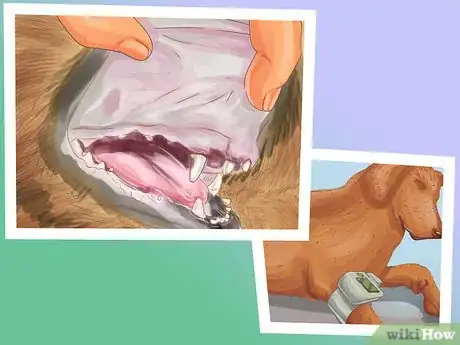This article was co-authored by Pippa Elliott, MRCVS. Dr. Elliott, BVMS, MRCVS is a veterinarian with over 30 years of experience in veterinary surgery and companion animal practice. She graduated from the University of Glasgow in 1987 with a degree in veterinary medicine and surgery. She has worked at the same animal clinic in her hometown for over 20 years.
This article has been viewed 12,375 times.
Kidney disease, also known as renal failure, can occur in two forms, acute and chronic. Acute kidney disease, which appears abruptly, usually occurs due to exposure to a toxic chemical or a trauma. Chronic kidney disease, on the other hand, is a slowly progressing disease that occurs due to age or hereditary factors. Both of these types of kidney disease have the same symptoms and can be a risk to your dog's health. If you have a senior dog, you should understand the signs of a problem with your dog's kidneys so that you can get the dog veterinary treatment as soon as possible.
Steps
Identifying the Signs of Kidney Disease
-
1Identify risk factors.[1] There are some factors that increase the likeliness that your dog will get kidney disease. If your dog has any risk factors, then it's important to keep a look out for signs of the disease. Your dog may have an increased chance of getting kidney disease if it has one or more of these risk factors:
- Advanced age.
- Certain breeds, such as Cocker spaniels, bull terriers, and German shepherds.
- Exposure to chemicals that damage kidneys, such as antifreeze, lead paint, or certain medications.
-
2Look for increased water consumption. A dog with kidney disease is likely to drink more water than normal. If your dog is drinking water constantly, as if it can never get enough, then it may be having some kidney troubles.[2]
- Of course, desire for water can vary depending on your dog's activity and the environmental conditions it is in. For example, if your dog has been running around on a hot day, it may want to drink more water than normal. Take these factors into consideration when assessing whether your dog is drinking more water than it should need.
Advertisement -
3Pay attention to changes in the frequency of your dog's urination. If your dog is drinking more water then it will likely be urinating more. However, kidney disease can also cause your dog to urinate less if the fluid builds up in the body instead of being expelled.[3]
- So, either excessive urination or lack of urination can both occur with kidney disease.
-
4Notice signs of digestive distress. A lack of proper kidney function can cause your dog a variety of forms of digestive distress. These can include diarrhea, vomiting, and constipation.[4]
- Digestive distress can signal a variety of health problems. However, if your dog is having repeated episodes of vomiting or diarrhea, no matter what the cause, it should be seen by a veterinarian.
-
5Look for lack of appetite and signs of weight loss. Lack of kidney function allows for waste to build up in the body. This buildup can inhibit your dog's appetite, leading to weight loss.[5]
- If you know what your dog normally weighs it will be easier to assess whether it has lost weight or not. Thus, it's a good idea to keep track of your dog's weight on a regular basis.
Getting a Veterinary Diagnosis
-
1Take your dog to a veterinarian. If you suspect that your dog has kidney disease then you should get it checked out by a veterinarian. Call your veterinary office and tell them about your dog's problem. They will then give you an appointment for when to bring the dog in.[6]
- It is a good idea to keep a record of your dog's symptoms. Write them down so that you can give the veterinarian an accurate account of your dog's issues.
-
2Have your veterinarian to do a thorough examination. In addition to getting your account of the dog's symptoms, your veterinarian will do a physical examination of your dog. The vet will be looking for additional symptoms that may signal a problem with the dog's kidneys. These include:[7]
- Pale gums.
- Enlarged and painful kidneys.
- Ulcers in the mouth.
- Fluid accumulation in the body.
- Dehydration.
- High blood pressure.
-
3Allow additional testing. Your veterinarian may need to do additional testing to verify that your dog has kidney disease. These tests could include blood testing, urine testing, radiography, and ultrasonography exams.[8] Each of these tests can tell your veterinarian something different about your dog's condition.
- This testing can also help verify the extent of the problem so that your veterinarian can figure out the best treatment options for your dog's specific condition.
Getting Veterinary Treatment
-
1Change your dog's diet. If your dog has kidney disease then your veterinarian is likely to suggest a change to its diet. Kidney disease can be caused, or enhanced, by foods that are high in phosphorus and protein.[9]
- There are special diets made for dogs with kidney disease that have reduced levels of phosphorus and protein.
- Feeding your dog a diet that is made for dogs with renal failure can improve your dog's health and extend its life expectancy.
-
2Give your dog plenty of water. If your dog has kidney disease it can get dehydrated more easily. Be sure to supply water to your pet at all times so that it can avoid dehydration.[10]
- If your dog is refusing to drink enough water then you can encourage your dog to drink by adding low-sodium broth to the dog's water.
-
3Treat associated conditions. Kidney failure can impact a variety of your dog's body systems. For example, kidney failure can cause your dog to become anemic and to have high blood pressure. Both of these conditions can be treated effectively in most cases with medication and lifestyle changes.[11]
- Unfortunately, treatments used for kidney disease in humans, such as dialysis, are not available for dogs. Instead, treatment is usually focused on just treating the additional conditions caused by the kidney disease.[12]
References
- ↑ http://www.iris-kidney.com/education/risk_factors.html
- ↑ https://www.vetmed.wsu.edu/outreach/Pet-Health-Topics/categories/diseases/chronic-kidney-disease-and-failure
- ↑ http://www.pethealthnetwork.com/dog-health/dog-diseases-conditions-a-z/chronic-kidney-disease-what-does-kidney-failure-dogs-really
- ↑ http://www.petmd.com/dog/conditions/urinary/c_multi_renal_failure_chronic
- ↑ https://www.vetmed.wsu.edu/outreach/Pet-Health-Topics/categories/diseases/chronic-kidney-disease-and-failure
- ↑ http://www.drsfostersmith.com/pic/article.cfm?aid=2720
- ↑ http://www.peteducation.com/article.cfm?c=2+2114&aid=350
- ↑ http://www.peteducation.com/article.cfm?c=2+2114&aid=350
- ↑ https://www.vetmed.wsu.edu/outreach/Pet-Health-Topics/categories/diseases/chronic-kidney-disease-and-failure
- ↑ https://www.vetmed.wsu.edu/outreach/Pet-Health-Topics/categories/diseases/chronic-kidney-disease-and-failure
- ↑ https://www.vetmed.wsu.edu/outreach/Pet-Health-Topics/categories/diseases/chronic-kidney-disease-and-failure
- ↑ http://www.pethealthnetwork.com/dog-health/dog-diseases-conditions-a-z/chronic-kidney-disease-what-does-kidney-failure-dogs-really
About This Article
To diagnose kidney disease in senior dogs, look for increased water consumption and urination since dogs with kidney disease tend to drink more than normal. However, you should also monitor your dog to see if it's not urinating since kidney disease can cause fluids to build up in the body. Additionally, keep an eye out for signs of digestive distress such as repeated instances of diarrhea, vomiting, or constipation. You should also take note of your dog’s weight on a regular basis and watch for weight loss and reduced appetite. For more tips from our Veterinary co-author, including how to get an official diagnosis and treat your dog’s symptoms, read on!


































































